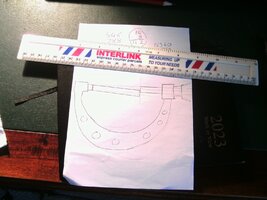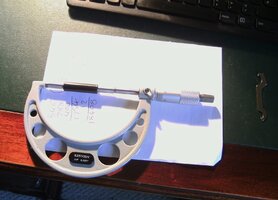Kojack
XS650 Enthusiast
I remember working in the machine shop. One day an apprentice came up looked at the micrometer I was using, and asked; " can I borrow that c-clamp?" That was a good laugh. 
They make wonderful lamp holders for shelving.I remember working in the machine shop. One day an apprentice came up looked at the micrometer I was using, and asked; " can I borrow that c-clamp?" That was a good laugh.

It seems unlikely that the bore would be under factory specs. Perhaps it went out of round? Check across several areas and see if it averages out. If that's the case then it's probably better to bore oversize.Using my new telescoping gauge, micrometer and the guidance shown by Jim https://www.xs650.com/threads/2003-royal-enfield-500-deluxe.60842/post-816588, today made a first attempt at taking bore measurements.
A little way down the bore, on the thrust face 3.3053"
At the same height, non-thrust face 3.3044"
Halfway down the bore, thrust face 3.3051"
Now, those numbers are not to be taken for granted! At the bottom of the bore, I measured 3.2983 which I think must be wrong because if my arithmetic is correct that is 7 thou smaller than at the top. Surely not?
Was a useful exercise in faffing about. I learned you either need more than two hands or use a vice to just hold the micrometer while measuring the t-scope. Will come at it again fresh tomorrow and see how my results vary from today.
The manual gives the bore size nominal 84mm, actual 83.96/83.97 which would be 3.3055 - 3.3059. The manual does not clarify manufactured size or the wear limit. I read it as specified size but all my measurements are smaller than wot the book gives.
What have I learned today? Notalot. Well, it might mean that the bore is still in spec for standard piston and rings. More helpfully, it means that if I buy Hitchcocks lovely forged piston in +20 thou there's plenty meat for the engineers to work with.
At the moment, this is on my shopping list https://accessories.hitchcocksmotorcycles.com/23261?cont_page=accessory-shop/cylinder&model=15
Was a useful exercise in faffing about. I learned you either need more than two hands or use a vice to just hold the micrometer while measuring the t-scope. Will come at it again fresh tomorrow and see how my results vary from today.
I spent 25 years learning to use the mic and t-gage. I always, always took several readings to verify size. The other thing to be careful of is how much you tighten the screw on the gage. Too loose and it can slip back. Too tight and it can deform enough to affect the reading.It's a practice thing Raymond. Rest the mic on a workbench with the thimble hanging off the edge. One hand holds the T gauge and holds the mic down against the bench at the same time. The other turns the thimble. It's pretty natural once you get the hang of it.... practice, practice, practice.
Also.... The ratchet stop on some newer mics can be pretty stiff. Stiff enough that they'll actually compress the T gauge slightly, giving a false reading.
Try closing the mic on the T gauge without the ratchet clicking. That'll eliminate the possibility of the T gauge being compressed as you're trying to measure. That make sense?
Fwiw... my students would spend an entire day learning to use a mic and T gauge. I'd put various pistons, cylinders, bushings and a host of other stuff out on a bench. At the end of the day they were pretty consistent and competent. It all comes down to practice.
Also, don't discount the possibility your mic isn't correctly calibrated. Do you have anything with a known size you can compare it to? Did it come with a "standard?" Can you take it to a local engineer (mechanic) and have him compare it to one of his?
View attachment 257414
Or I could say, 'The hell with it, this is a pre-WW2 designed engine, I'll just buy a Std piston and she'll be fine'.


Could you put the standard measure in a vice to hold whilst you adjust the mic?Well, been having fun trying to zero the mic. Nothing is easy, or they'd all be doin it? Haven't actually counted how many times I've gently closed the mic on that 3" measure, zero'd, backed off, gently closed and . . . it's wrong again.
View attachment 257986
Quick n durty sketch what I think might be happening. If the anvils in the mic pick up on the measure just slightly squint - exaggerated on the sketch - then the gap is too big and next time I check we're off again. Sommat that lends credence to this hypothesis is that when the mic picks up on the 3" measure, it tries to turn and move it.
Eventually, arrived at this:
View attachment 257987
Light's not good but the zero lines up.
Gonna call that good. But even then you can see the measure isn't quite straight in the mic. Oh, been using the holding over the edge of the desk method to fiddle with the mic. How many of us have adopted the over the edge of the desk position for a bit of fiddling I wonder . . .
Enough for just now. As Jim and @Kojack both said, little bit of practice needed.
Good thing this isn't a rush job.

Raymond, I took a short video of using the standard as I described, but even after editing and cropping to make the file smaller the server here chokes on it so wasn't able to post it. Only 7 seconds of video.
